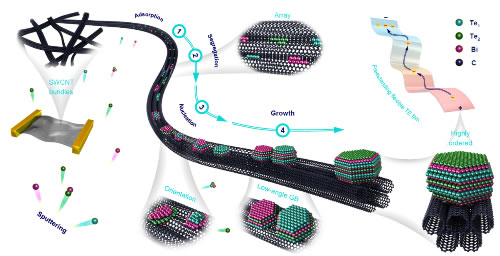Thermoelectric material is a kind of "green" energy material that can convert "heat energy" and "electric energy" without any external force. It can use waste heat in life and production to generate electricity, or achieve accurate heat transfer under the application of bias voltage. , Widely used in the field of temperature difference battery power supply, micro-system chip temperature control and refrigeration. The traditional thermoelectric materials are inorganic covalent bond / ion bond crystals. For example, bismuth telluride (Bi2Te3) is the most widely used thermoelectric material. Its periodic layered structure is covalent bond / ion bond connection, and the interlayer is The weak van der Waals connection is inherently brittle and cannot be deformed flexibly. Traditional thermoelectric materials cannot closely fit heat source surfaces with complex curvature changes (such as heat source pipes, human body surfaces, etc.) in practical applications. Such poor thermal contact leads to heat loss and low thermoelectric conversion efficiency; it is also difficult to adapt to thermoelectricity The devices are increasingly miniaturized and highly integrated. Therefore, the research and development of high-performance flexible thermoelectric materials has become the focus and difficulty of research in this field. Recently, the research team of Tai Kaiping and Liu Chang of the Institute of Metal Research, Chinese Academy of Sciences and collaborators have developed a high-performance bismuth telluride / single-wall carbon nanotube (Bi2Te3 / SWCNT) flexible thermoelectric material. The researchers used an independently designed and improved magnetron sputtering deposition system, using a three-dimensional network of self-supporting carbon nanotubes with excellent mechanical and electrical properties as a skeleton, and using sub-nanoscale carbon tube bundle grooves to limit diffusion and induce ordered nucleation and The temperature-selective crystal plane growth mechanism of thin-film materials was the first to prepare Bi2Te3 / SWCNT composite self-supporting thermoelectric thin-film materials with highly ordered microscopic features. The composite material has a nano-pore structure, the deposited Bi2Te3 nano-grain is closely attached to the surface of the carbon nanotube bundle, and has a high (000l) surface texture, the Bi2Te3 <-12-10> crystal direction is parallel to the carbon nanotube bundle axis, adjacent Bi2Te3 nano-grains are tilted at a small angle to the grain boundaries. The Bi2Te3 (000l) plane texture is conducive to improving carrier in-plane conduction. Small-angle grain boundaries can further reduce its scattering effect on conductive carriers. Defects such as nanopore structure and Bi2Te3 / SWCNT interface play a role in reducing scattering phonons. The role of thermal conductivity. Studies have shown that in this (000l) plane texture, the -Te1-Te1-atomic plane connected by weak van der Waals forces is parallel to the free surface of the composite film, and the relative motion between the van der Waals forces is that the composite film exhibits a bending deformation along the surface. An important mechanism of good flexibility, the adjacent Bi2Te3 <-12-10> crystal orientation is highly consistent, and it is the easy slip direction on the (000l) van der Waals surface, which is beneficial for van der Waals interlayer displacement between adjacent grains Of passing. In addition, the nano-pore structure is also conducive to accommodating the relative displacement of the material during flexible deformation, which further improves the ability of flexible deformation. The unique microstructure endows the composite material with a thermoelectric figure of merit (ZT) of up to ~ 0.9 in the (000l) in-plane direction from room temperature to 100 degrees Celsius, which is comparable to the commercial block brittle thermoelectric material ZT performance and has very excellent Mechanical properties of bending flexibility. Further research shows that because the composite material has good bending flexibility and self-supporting structure, it can be cut into arbitrary geometric shapes and transferred to various types of substrates using micro-nano processing methods such as ion beams and femtosecond lasers. It is conducive to flexible and convenient preparation of thermoelectric devices of various structures, and even the composite thermoelectric material can be controlled by non-contact methods such as electrostatic force. At the same time, research shows that the preparation principle and technology of the composite material can also be applied to other layered semiconductor material systems with weak van der Waals connections, and has broad application prospects in the field of flexible semiconductor materials and devices. Related research results "Flexible layer-structured Bi2Te3 thermoelectric ona carbon nanotube scaffold" were published online in "Nature Materials" on November 19. This work was supported by the National Key Research and Development Program, the National Natural Science Foundation of China, the Equipment Research Project of the Chinese Academy of Sciences, the Hundred Talents Program of the Chinese Academy of Sciences, and Tan Jun, a researcher at the Institute of Public Technical Services of the Institute of Metals.
1. Application : For Medical Accessory
OD
OD Tolerance
ID
Tolerance
Roundness
Straightness
Circular
run-out
φ16-20
±0.02
±0.02
0.01↓
0.015↓
0.05↓
φ20-30
±0.02
±0.02
0.01↓
0.015↓
0.05↓
φ30-50
±0.05
±0.05
0.02↓
0.020↓
0.08↓
φ50-80
±0.15
±0.10
0.05↓
0.025↓
0.10↓
7. Trade Terms Aluminum Profile For Medical Accessory Aluminum Profile For Medical Accessory,Medical Aluminum Profile,Aluminum Extrusion Medical Profile,Medical Aluminium 3003 Profile Changzhou YiFei Machinery Co., Ltd. , https://www.yifeialu.com
Figure 1 Schematic diagram of the growth structure of Bi2Te3-SWCNT composite self-supporting thermoelectric thin film material 
Figure 2 Thermoelectric performance analysis of Bi2Te3-SWCNT composite material 
Fig.3 Analysis of bending flexibility of Bi2Te3-SWCNT composites and MD molecular dynamics simulation
2. Dimension: Customized dimension, OEM & ODM
3.Material: A6063, A6061, A3003 and other series alu alloy
4.Suface treatment: Anodizing, polishing, turning ,power coating, mill finish etc
5.Equipment: CNC ,extruding machine, cold drawn machine, heating oven, straightening machine, cutting machine
6. STANDARD PACKING:Wooden case/carton
1. Payment: 30% T/T in advance, 70% balance pay before delivery. L/C at sight.
2. Delivery time: 20 days after deposit receiverd. If opening mould, plus 7-10 days.
3. Trade Term can be chosen depending on your requirements.
4. FOB Port: Shanghai
Contact Us
If you want more info.about the aluminum tubes/profiles, please feel free to contact us.
1. Attn: Karina Gu
2. Mobile: +86-18961469527
3. Tel: +86-519-88761254